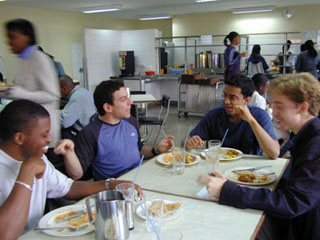
Student conversation. (Image courtesy of the MIT African Internet Technology Initiative.)
Instructor(s)
Prof. Bernd Widdig
Dr. Lori Breslow
MIT Course Number
21G.019 / 21G.021
As Taught In
Spring 2005
Level
Undergraduate / Graduate
Translated Versions
Course Description
Course Description
It has become commonplace knowledge that globalization is one of the major forces shaping our world. If we look at the spread of information, ideas, capital, media, cultural artifacts - or for that matter, people - we can see the boundaries and borders that have historically separated one country or one group from another are becoming more and more permeable. For proof of this close to home, you need only to look at the composition of the MIT student body: 8 percent of the undergraduates and 37 percent of the graduate students are from 109 different countries.
"Communicating Across Cultures" is designed to help you meet the challenges of living in a world in which, increasingly, you will be asked to interact with people who may not be like you in fundamental ways. Its primary goals are to help you become more sensitive to intercultural communication differences, and to provide you with the knowledge and skills that will help you interact successfully with people from cultures other than your own. We hope the course will accomplish those goals by exposing you to some of the best writers and scholars on the subject of intercultural communication, and by giving you a variety of opportunities to practice intercultural communication yourself. As you read the syllabus for this course, we hope you get a sense of our commitment to making this course a rewarding experience for you.


